31 mar 2016
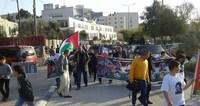
The Israeli Occupation Forces (IOF) suppressed on Wednesday evening a peaceful march in Doheisheh refugee camp, south of Bethlehem, in commemoration of the Land Day.
The PIC reporter said that the march started from Doheisheh camp heading towards the northern entrance of Bethlehem.
The participants waved Palestinian flags and raised photos of Palestinian martyrs whose bodies are still detained by Israeli authorities, some of whom, for dozens of years.
Israeli forces attacked the peaceful march with teargas bombs. Dozens of participants choked on tear gas. Palestinian youths responded by throwing stones at the soldiers.
Meanwhile, dozens of Palestinian refugees marked on Wednesday the Land Day in Yarmouk refugee camp in Syria despite the tight siege imposed on the camp.
The commemoration event came in coincidence with the arrival of a Swedish aid convoy to the besieged camp. Hundreds of food parcels were distributed in Yarmouk camp. Coordinator for the aid convoy Khaled Youssef revealed that a second convoy will be organized before the holy month of Ramadan.
The PIC reporter said that the march started from Doheisheh camp heading towards the northern entrance of Bethlehem.
The participants waved Palestinian flags and raised photos of Palestinian martyrs whose bodies are still detained by Israeli authorities, some of whom, for dozens of years.
Israeli forces attacked the peaceful march with teargas bombs. Dozens of participants choked on tear gas. Palestinian youths responded by throwing stones at the soldiers.
Meanwhile, dozens of Palestinian refugees marked on Wednesday the Land Day in Yarmouk refugee camp in Syria despite the tight siege imposed on the camp.
The commemoration event came in coincidence with the arrival of a Swedish aid convoy to the besieged camp. Hundreds of food parcels were distributed in Yarmouk camp. Coordinator for the aid convoy Khaled Youssef revealed that a second convoy will be organized before the holy month of Ramadan.
30 mar 2016
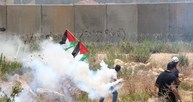
Dozens of Palestinians suffered different injuries Wednesday afternoon after Israeli Occupation Forces (IOF) suppressed Land Day marches in Nablus north of occupied West Bank.
Local institutions and national forces organized on Wednesday an event in the evacuated Homesh settlement in Nablus marking the Palestinian Land Day.
Head of the village council of Burqa, Sami Douglas, told the PIC reporter that Israeli forces were deployed at the entrance of the evacuated settlement and the entrances of the nearby villages and prevented locals from participating in the event amid heavy fire of teargas bombs.
A number of participants were detained for few hours before being released, while others suffered effects of teargas inhalation. Large land tracts of Burqa town were previously confiscated and turned into Homesh settlement before an Israeli court ordered its evacuation in 2005.
However, Israeli forces continue to prevent Palestinians from entering the evacuated settlement while allowing setters in. Meanwhile, IOF soldiers suppressed Wednesday a Palestinian march near Ofer prison southwest of Ramallah marking the 40th anniversary of the Land Day.
Israeli border guards were deployed in large numbers in the area and heavily fired teargas bombs at the peaceful protesters. During the march, protesters held banners and chanted slogans stressing their adherence to each inch of Palestinian land and to the right of return.
Local institutions and national forces organized on Wednesday an event in the evacuated Homesh settlement in Nablus marking the Palestinian Land Day.
Head of the village council of Burqa, Sami Douglas, told the PIC reporter that Israeli forces were deployed at the entrance of the evacuated settlement and the entrances of the nearby villages and prevented locals from participating in the event amid heavy fire of teargas bombs.
A number of participants were detained for few hours before being released, while others suffered effects of teargas inhalation. Large land tracts of Burqa town were previously confiscated and turned into Homesh settlement before an Israeli court ordered its evacuation in 2005.
However, Israeli forces continue to prevent Palestinians from entering the evacuated settlement while allowing setters in. Meanwhile, IOF soldiers suppressed Wednesday a Palestinian march near Ofer prison southwest of Ramallah marking the 40th anniversary of the Land Day.
Israeli border guards were deployed in large numbers in the area and heavily fired teargas bombs at the peaceful protesters. During the march, protesters held banners and chanted slogans stressing their adherence to each inch of Palestinian land and to the right of return.
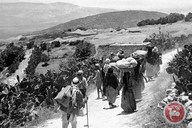
Thousands of Palestinians across Israel and the occupied Palestinian territory marched Wednesday to commemorate the 40th Land Day, protesting decades of Israeli land grabs.
"Palestinians are entitled to their land and they will give up not one inch," Hamas official Yehya Mousa said at a rally in Gaza City to remember the Palestinian protests against Israeli land seizures that were violently suppressed on March 30, 1976.
Hundreds of Gazans marched from the city towards the Erez crossing in the coastal enclave's north, waving Palestinian flags and demanding the right of return of Palestinian refugees forced to leave their land when Israel was established in 1948.
Senior Fatah leader Zakariyya al-Agha also addressed Gaza's rally, telling protesters: "The martyrs who fell on that day embodied national unity," in reference to the six unarmed Palestinians gunned down 40 years ago.
"As the Palestinian people mark Land Day, they are still facing an (Israeli) policy based on ethnic cleansing and land confiscation, and the Netanyahu government continues with its racist plans to deport the Palestinians and build Israeli settlements and separation walls," he said.
In the occupied West Bank's Ramallah district, Palestinian students from al-Quds Open University and Modern University College who were marking Land Day managed to cut through a barbed-wire section of Israel's separation wall east of al-Bireh.
The students crossed the wall, reaching confiscated agricultural lands and raising a Palestinian flag before Israeli forces intervened. Forces then chased the demonstrators firing rubber-coated steel bullets, sound bombs, and tear gas.
The PLO for its part slammed Israel's "racist" policy of allocating land solely for its Jewish population at the expense of the land's indigenous Palestinian population.
"Rather than supporting the two-state solution on the 1967 border, the Israeli government continues to consider all of historic Palestine as part of Israel with the aim to impose two different systems, an Apartheid regime," PLO Secretary-General Saeb Erekat said in a statement.
There were mass rallies inside Israel too, including in Umm al-Hiran, a Bedouin community in the Negev which Israel plans to displace in order to expand the suburbs of Beersheba city.
Both Palestinians and Israeli activists took part in the protest, including the head of Israeli group Rabbis for Human Rights, Rabbi Arik Ascherman.
This year's Land Day commemorations follow a new wave of land grabs in the occupied Palestinian territory that rights groups say mark a return to an Israeli government policy not seen since the pre-Oslo period in the 1980s.
Condemning these confiscations, Israeli settlement watchdog Peace Now has said that "instead of trying to calm the situation, the government is adding fuel to the fire and sending a clear message to Palestinians, as well as to Israelis, that it has no intention to work towards peace and two states."
Despite repeated condemnations by the international community, Israel has come under little actual pressure to halt its settlement program, land seizures, or the forced displacement of Palestinian communities.
"Palestinians are entitled to their land and they will give up not one inch," Hamas official Yehya Mousa said at a rally in Gaza City to remember the Palestinian protests against Israeli land seizures that were violently suppressed on March 30, 1976.
Hundreds of Gazans marched from the city towards the Erez crossing in the coastal enclave's north, waving Palestinian flags and demanding the right of return of Palestinian refugees forced to leave their land when Israel was established in 1948.
Senior Fatah leader Zakariyya al-Agha also addressed Gaza's rally, telling protesters: "The martyrs who fell on that day embodied national unity," in reference to the six unarmed Palestinians gunned down 40 years ago.
"As the Palestinian people mark Land Day, they are still facing an (Israeli) policy based on ethnic cleansing and land confiscation, and the Netanyahu government continues with its racist plans to deport the Palestinians and build Israeli settlements and separation walls," he said.
In the occupied West Bank's Ramallah district, Palestinian students from al-Quds Open University and Modern University College who were marking Land Day managed to cut through a barbed-wire section of Israel's separation wall east of al-Bireh.
The students crossed the wall, reaching confiscated agricultural lands and raising a Palestinian flag before Israeli forces intervened. Forces then chased the demonstrators firing rubber-coated steel bullets, sound bombs, and tear gas.
The PLO for its part slammed Israel's "racist" policy of allocating land solely for its Jewish population at the expense of the land's indigenous Palestinian population.
"Rather than supporting the two-state solution on the 1967 border, the Israeli government continues to consider all of historic Palestine as part of Israel with the aim to impose two different systems, an Apartheid regime," PLO Secretary-General Saeb Erekat said in a statement.
There were mass rallies inside Israel too, including in Umm al-Hiran, a Bedouin community in the Negev which Israel plans to displace in order to expand the suburbs of Beersheba city.
Both Palestinians and Israeli activists took part in the protest, including the head of Israeli group Rabbis for Human Rights, Rabbi Arik Ascherman.
This year's Land Day commemorations follow a new wave of land grabs in the occupied Palestinian territory that rights groups say mark a return to an Israeli government policy not seen since the pre-Oslo period in the 1980s.
Condemning these confiscations, Israeli settlement watchdog Peace Now has said that "instead of trying to calm the situation, the government is adding fuel to the fire and sending a clear message to Palestinians, as well as to Israelis, that it has no intention to work towards peace and two states."
Despite repeated condemnations by the international community, Israel has come under little actual pressure to halt its settlement program, land seizures, or the forced displacement of Palestinian communities.
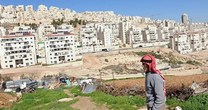
The Adalah Center listed in a report on Wednesday, prepared on the occasion of Land Day, the Israeli government tenders issued by the so-called Israel Land Authority and the Ministry of Construction and Housing in 2015.
The report showed that the continuation and escalation of the Israeli racist policies directly result in worsening the land and housing crisis in the Palestinian villages and cities within 1948 occupied Palestine.
According to the report prepared by lawyer Mohammed Bassam, "the examination of the government tenders confirms that the vast majority of tenders of marketing land and efforts to reduce housing prices are allocated for Jewish or mixed communities, while no efforts are made to solve the housing crisis in 136 Arab villages and cities in which lives 91% of the Palestinian community in the occupied territories of 1948."
Data published by Adalah in its report show that only 4.6% of the settlement units which the Israel Land Authority marketed in 2015, was dedicated to Arab communities which population is about 20% of the total population, while the authority marketed 38,095 housing units in the Jewish and mixed communities, but marketed only 1,835 housing units in Arab towns and villages.
Adalah report mentioned the rural towns listed in the "national preference" list which includes towns deserving a government subsidy of 20% to 70% of the budget of the development of new buildings. The list contains only 30 Arab villages out of 558 villages (i.e. the proportion is only 5%), while in practice, not all the towns listed get this support.
In 2015, 363 rural towns got this support, only three of which are Arab villages, which constitutes 0.8% only. The Adalah report stressed that the housing crisis in the Arab towns and villages is the result of a systematic policy which sees, since the establishment of Israel until today, the Arab society as an outsider and hostile society that contrasts fundamentally with the Zionist ideology of the Judaization of land.
The report suggests that, "Solutions to the housing crisis in the Palestinian community within the occupied territories in 1948 cannot be fair or effective without amending the continuing historical injustice against the Palestinian people.”
The report showed that the continuation and escalation of the Israeli racist policies directly result in worsening the land and housing crisis in the Palestinian villages and cities within 1948 occupied Palestine.
According to the report prepared by lawyer Mohammed Bassam, "the examination of the government tenders confirms that the vast majority of tenders of marketing land and efforts to reduce housing prices are allocated for Jewish or mixed communities, while no efforts are made to solve the housing crisis in 136 Arab villages and cities in which lives 91% of the Palestinian community in the occupied territories of 1948."
Data published by Adalah in its report show that only 4.6% of the settlement units which the Israel Land Authority marketed in 2015, was dedicated to Arab communities which population is about 20% of the total population, while the authority marketed 38,095 housing units in the Jewish and mixed communities, but marketed only 1,835 housing units in Arab towns and villages.
Adalah report mentioned the rural towns listed in the "national preference" list which includes towns deserving a government subsidy of 20% to 70% of the budget of the development of new buildings. The list contains only 30 Arab villages out of 558 villages (i.e. the proportion is only 5%), while in practice, not all the towns listed get this support.
In 2015, 363 rural towns got this support, only three of which are Arab villages, which constitutes 0.8% only. The Adalah report stressed that the housing crisis in the Arab towns and villages is the result of a systematic policy which sees, since the establishment of Israel until today, the Arab society as an outsider and hostile society that contrasts fundamentally with the Zionist ideology of the Judaization of land.
The report suggests that, "Solutions to the housing crisis in the Palestinian community within the occupied territories in 1948 cannot be fair or effective without amending the continuing historical injustice against the Palestinian people.”
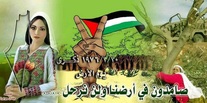
The following is a press release by the Palestinian Central Bureau of Statistic (PCBS), marking the fortieth anniversary of the Palestinian Land - March 30, 2016.
Israeli Occupation Authorities laid hand over more than 85% of the total area of historical land of Palestine which totals about 27,000 km2. Arabs comprise 48% of the total population but utilize only 15% of the land.
Israeli Occupation also set up a buffer zone along the border of the Gaza Strip extending over 1,500 m along the eastern border.
Consequently, the zone usurps about 24% of the total area of the Gaza Strip (365 km²), which is one of the most densely populated area in the world with about 5,000 capita/km².
Furthermore, Israeli Occupation maintains tight control over more than 90% of the area of the Jordan Valley, which constitutes 29% of the total area of the West Bank.
Every year, the Palestinian people remember the confiscation of 21 thousand Dunams of land in Al-Jalil (Galilee), Al-Mothallath and Al-Naqab (Negev) on 30 March 1976.
On this day, the Israeli authorities expropriated the land and responded violently to the protestations, killing six young demonstrators.
Jerusalem 2015; Intensive Judaizing
While the Israeli occupation authorities keep demolishing Palestinian houses and denying Palestinians the right to build any new houses, they grant permits to build thousands of housing units in the Israeli settlements in and around Jerusalem.
Only in 2015, they authorized the building of over 12,600 housing units in the Israeli settlements in East Jerusalem, in addition to 2,500 hotel rooms.
Moreover, the Israeli occupation authorities ratified regulations to replace the original Arabic names of the streets in the old town of Jerusalem by Hebrew ones.
This inscribes in Israel’s ongoing policy of Occupation of Jerusalem and falsification of its history and geography not to mention the imposition of new demographic facts on the ground.
The Israeli occupation authorities demolished about 152 Palestinian buildings (houses and establishments) and sent hundreds of demolition orders to owners of other buildings; moreover, the Israeli occupation authorities confiscated 546 Dunams of the Palestinian land in the Eesawiyya locality and Shu'fat camp to establish a national park and dumping site for wastes from illegal Jewish settlements.
Israeli Violations: Martyrs, Wounded and Prisoners
The number of martyrs reached 181 martyrs during the year 2015 were 32 martyrs of children and 9 women and 26 martyrs in the Gaza Strip, while the number of injured has risen during the year 2015 about 16,620 wounded, while the number of cases of detention amounted to about 6830 case, including 2,179 children.
Israeli Settlements: Unjust Expansion
There were 413 illegal Israeli constructions in the West Bank (including 150 settlements and 119 outposts) by the end of 2014.
Furthermore, the Israeli occupation authorities approved the building of over 4,500 housing units in the Israeli settlements in the West Bank Except those that were approved in Jerusalem.
Still, these same authorities deprived Palestinians of their right to build and laid obstacles, which undermine any potential urban expansion especially for the Palestinians in Jerusalem and Area "C" which is under full Israeli control.
It should be noted that Area “C” constitutes over 60% of the West Bank area. Israel also erected its Expansion and Annexation Wall, which isolates more than 12% of the West Bank land.
Data indicated that the total number of settlers in the West Bank was 599,901 at the end of 2014, 286,997 of whom in the Jerusalem Governorate (they represent 48% of all settlers in the occupied West Bank). 210,420 of these illegal settlers live in Jerusalem J1 (that part of Jerusalem, which was annexed forcefully by Israel following its occupation of the West Bank in 1967).
In demographic terms, the proportion of settlers to the Palestinian population in West Bank is around 21 settlers per 100 Palestinians compared with 69 settlers per 100 Palestinians in Jerusalem governorate.
Environment: Continuing Degradation
Israeli settlements cause direct damage to the Palestinian environment. They actually discharge 40 million cubic meters (mcm) of wastewater annually into Palestinian valleys and agricultural land.
Only 10% of such water is treated. If compared to the wastewater produced by Palestinians in the West Bank, which stands at 34 mcm per year, Israeli settlers produce five times the Palestinian.
Moreover, the Israeli authorities prevent Palestinians from building their own wastewater treatment plants. On another level, they allocated part of the Palestinian land in Jordan Valley to an Israeli dumpsite of industrial waste.
Consequently, Palestinian agricultural land endured enormous damage not to mention impact on health animals and biodiversity, in addition to the Israeli authorities bulldozed and burned more than 15,300 trees of Palestinian farmers during the year 2015.
Water: Deficiency and Suffering
Like other Arab countries, Palestine suffers from scarcity of water and resources.
However, the situation in Palestine is more complex because of prolonged Israeli occupation, which controls most of the existing water sources and prevents the Palestinians of their right to access their water sources or any alternative sources.
The Israeli occupation controls the majority of renewable water resources totaling 750 MCM (Million Cubic Meter), while Palestinians receive only about 110 MCM.
The Palestinian share from the three groundwater aquifers should be 118 MCM according to Oslo Agreement II. This share was supposed to increase to 200 MCM by the year 2000 had the Interim Agreement been fully implemented.
Buildings: Demolish of Housing Units and Establishments
On the fortieth remembrance of the Land Day, the Israeli occupation violations against the Palestinians continue, in terms of land confiscation, demolition of buildings (housing units and establishments) and forcible displacement of residents. Israeli occupation authorities usurped 6,386 Dunams of Palestinian land in the various governorates of the West Bank in 2015.
Furthermore, they demolished 645 building (houses and establishments), forcibly displacing 2,180 persons in the West Bank and East Jerusalem, 1,108 of whom are children.
They also threatened to demolish 780 building, at a time when the needs of housing units for Palestinian increase.
In figures, 60.9% of households in Palestine need to build new housing units over the next decade according to the reported data survey of housing conditions in 2015 (one residential unit or more).
Tourism: Israeli Monopoly
The Israeli narrative is based on falsification of the culture, civilization and history of Palestine. Therefore, the occupation authorities alter Palestinian national treasures and monuments of ancient times.
In figures, 53% of the archeological sites in Palestine are in Area "C", which is under full Israeli control. The Israel occupation prevents any excavating or restoration of these sites for the building of recreational and tourist attractions.
They also create obstacles to prevent Palestinian tourism agencies from organizing proper visits of the Holy Land.
With these restrictions, they give a competitive edge to the Israeli companies that market the Nativity Church in Bethlehem and Deir Quruntol in Jericho, for instance, as part of tourism in Israel.
By granting more facilities to Israeli companies, tourists are ‘advised’ to stay in Israeli hotels as Palestinian areas are ‘denounced as unsafe’. With these measures, Palestinians are deprived of over 75% of potential touristic services revenues.
Sources:
1. Palestinian Central Bureau of Statistics 2015: Israeli settlements in the West Bank, 2014. Ramallah- Palestine
2. Abdullah Al-Hourani Center for Studies and Documentation, Annual Report, 2015.
3. National Office for the Defense of the Land and Resist Settlement, Impact of Israeli Settlements on the Palestinian Environment. 2016
4. Land Research Center report of the Association Arab Studies, Sum of Israeli Violations Against the Palestinian Right to Housing and Land.
5. Ministry of Tourism and Antiquities, 2015.
Israeli Occupation Authorities laid hand over more than 85% of the total area of historical land of Palestine which totals about 27,000 km2. Arabs comprise 48% of the total population but utilize only 15% of the land.
Israeli Occupation also set up a buffer zone along the border of the Gaza Strip extending over 1,500 m along the eastern border.
Consequently, the zone usurps about 24% of the total area of the Gaza Strip (365 km²), which is one of the most densely populated area in the world with about 5,000 capita/km².
Furthermore, Israeli Occupation maintains tight control over more than 90% of the area of the Jordan Valley, which constitutes 29% of the total area of the West Bank.
Every year, the Palestinian people remember the confiscation of 21 thousand Dunams of land in Al-Jalil (Galilee), Al-Mothallath and Al-Naqab (Negev) on 30 March 1976.
On this day, the Israeli authorities expropriated the land and responded violently to the protestations, killing six young demonstrators.
Jerusalem 2015; Intensive Judaizing
While the Israeli occupation authorities keep demolishing Palestinian houses and denying Palestinians the right to build any new houses, they grant permits to build thousands of housing units in the Israeli settlements in and around Jerusalem.
Only in 2015, they authorized the building of over 12,600 housing units in the Israeli settlements in East Jerusalem, in addition to 2,500 hotel rooms.
Moreover, the Israeli occupation authorities ratified regulations to replace the original Arabic names of the streets in the old town of Jerusalem by Hebrew ones.
This inscribes in Israel’s ongoing policy of Occupation of Jerusalem and falsification of its history and geography not to mention the imposition of new demographic facts on the ground.
The Israeli occupation authorities demolished about 152 Palestinian buildings (houses and establishments) and sent hundreds of demolition orders to owners of other buildings; moreover, the Israeli occupation authorities confiscated 546 Dunams of the Palestinian land in the Eesawiyya locality and Shu'fat camp to establish a national park and dumping site for wastes from illegal Jewish settlements.
Israeli Violations: Martyrs, Wounded and Prisoners
The number of martyrs reached 181 martyrs during the year 2015 were 32 martyrs of children and 9 women and 26 martyrs in the Gaza Strip, while the number of injured has risen during the year 2015 about 16,620 wounded, while the number of cases of detention amounted to about 6830 case, including 2,179 children.
Israeli Settlements: Unjust Expansion
There were 413 illegal Israeli constructions in the West Bank (including 150 settlements and 119 outposts) by the end of 2014.
Furthermore, the Israeli occupation authorities approved the building of over 4,500 housing units in the Israeli settlements in the West Bank Except those that were approved in Jerusalem.
Still, these same authorities deprived Palestinians of their right to build and laid obstacles, which undermine any potential urban expansion especially for the Palestinians in Jerusalem and Area "C" which is under full Israeli control.
It should be noted that Area “C” constitutes over 60% of the West Bank area. Israel also erected its Expansion and Annexation Wall, which isolates more than 12% of the West Bank land.
Data indicated that the total number of settlers in the West Bank was 599,901 at the end of 2014, 286,997 of whom in the Jerusalem Governorate (they represent 48% of all settlers in the occupied West Bank). 210,420 of these illegal settlers live in Jerusalem J1 (that part of Jerusalem, which was annexed forcefully by Israel following its occupation of the West Bank in 1967).
In demographic terms, the proportion of settlers to the Palestinian population in West Bank is around 21 settlers per 100 Palestinians compared with 69 settlers per 100 Palestinians in Jerusalem governorate.
Environment: Continuing Degradation
Israeli settlements cause direct damage to the Palestinian environment. They actually discharge 40 million cubic meters (mcm) of wastewater annually into Palestinian valleys and agricultural land.
Only 10% of such water is treated. If compared to the wastewater produced by Palestinians in the West Bank, which stands at 34 mcm per year, Israeli settlers produce five times the Palestinian.
Moreover, the Israeli authorities prevent Palestinians from building their own wastewater treatment plants. On another level, they allocated part of the Palestinian land in Jordan Valley to an Israeli dumpsite of industrial waste.
Consequently, Palestinian agricultural land endured enormous damage not to mention impact on health animals and biodiversity, in addition to the Israeli authorities bulldozed and burned more than 15,300 trees of Palestinian farmers during the year 2015.
Water: Deficiency and Suffering
Like other Arab countries, Palestine suffers from scarcity of water and resources.
However, the situation in Palestine is more complex because of prolonged Israeli occupation, which controls most of the existing water sources and prevents the Palestinians of their right to access their water sources or any alternative sources.
The Israeli occupation controls the majority of renewable water resources totaling 750 MCM (Million Cubic Meter), while Palestinians receive only about 110 MCM.
The Palestinian share from the three groundwater aquifers should be 118 MCM according to Oslo Agreement II. This share was supposed to increase to 200 MCM by the year 2000 had the Interim Agreement been fully implemented.
Buildings: Demolish of Housing Units and Establishments
On the fortieth remembrance of the Land Day, the Israeli occupation violations against the Palestinians continue, in terms of land confiscation, demolition of buildings (housing units and establishments) and forcible displacement of residents. Israeli occupation authorities usurped 6,386 Dunams of Palestinian land in the various governorates of the West Bank in 2015.
Furthermore, they demolished 645 building (houses and establishments), forcibly displacing 2,180 persons in the West Bank and East Jerusalem, 1,108 of whom are children.
They also threatened to demolish 780 building, at a time when the needs of housing units for Palestinian increase.
In figures, 60.9% of households in Palestine need to build new housing units over the next decade according to the reported data survey of housing conditions in 2015 (one residential unit or more).
Tourism: Israeli Monopoly
The Israeli narrative is based on falsification of the culture, civilization and history of Palestine. Therefore, the occupation authorities alter Palestinian national treasures and monuments of ancient times.
In figures, 53% of the archeological sites in Palestine are in Area "C", which is under full Israeli control. The Israel occupation prevents any excavating or restoration of these sites for the building of recreational and tourist attractions.
They also create obstacles to prevent Palestinian tourism agencies from organizing proper visits of the Holy Land.
With these restrictions, they give a competitive edge to the Israeli companies that market the Nativity Church in Bethlehem and Deir Quruntol in Jericho, for instance, as part of tourism in Israel.
By granting more facilities to Israeli companies, tourists are ‘advised’ to stay in Israeli hotels as Palestinian areas are ‘denounced as unsafe’. With these measures, Palestinians are deprived of over 75% of potential touristic services revenues.
Sources:
1. Palestinian Central Bureau of Statistics 2015: Israeli settlements in the West Bank, 2014. Ramallah- Palestine
2. Abdullah Al-Hourani Center for Studies and Documentation, Annual Report, 2015.
3. National Office for the Defense of the Land and Resist Settlement, Impact of Israeli Settlements on the Palestinian Environment. 2016
4. Land Research Center report of the Association Arab Studies, Sum of Israeli Violations Against the Palestinian Right to Housing and Land.
5. Ministry of Tourism and Antiquities, 2015.
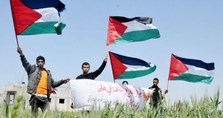
The Palestinian people mark Wednesday the 40th anniversary of the Palestinian Land Day amid calls for general strike and marches throughout the occupied territories.
A general strike was declared in the Palestinian towns and cities within the Green Line since the early morning hours. Two popular marches are also scheduled to be organized in the afternoon in Battof and Negev in commemoration of the Land Day.
The participants will first visit the tombs of the six Palestinian citizens who were killed on March 30, 1976.
The Higher Monitoring Committee has called for massive participation in the general strike and in the events. Similar marches and events are scheduled to be organized today throughout the West Bank, Gaza Strip, and in the diaspora marking the Land Day.
In Gaza Strip, activists started on Tuesday planting trees along the border fence between Gaza and the 1948 occupied territories.
On March 30, 1976, Israeli police repressed protests by Palestinian citizens against the confiscation of Arab land in the Galilee for use by Jewish settlers. Six protesters were killed, some 100 wounded and hundreds were arrested. Ever since, Palestinians in occupied Palestine and the diaspora mark Land Day on March 30.
Palestinians prepare to march on 40th Land Day
Palestinians on Wednesday marked the 40th anniversary of Land Day, commemorating Palestinian protests against Israeli land seizures that were violently suppressed on March 30, 1976.
In recent years, Palestinians across both Israel and the occupied Palestinian territory have marched to mark the occasion, while large numbers of Israeli troops have been deployed to suppress the protests, frequently opening fire on the crowds.
This year's marches will follow a new wave of massive land grabs in the occupied Palestinian territory that rights groups say marks a return to an Israeli government policy not seen since the pre-Oslo period in the 1980s.
Earlier this month, Israeli declared 2,342 dunams (580 acres) of land to the south of Jericho "state land" to pave the way for the construction of 358 housing units in the illegal settlement of Almog.
The land confiscation south of Jericho followed that of around 5,000 dunams (1,240 acres) of Palestinian land in Bethlehem district in 2014.
"Instead of trying to calm the situation, the government is adding fuel to the fire and sending a clear message to Palestinians, as well as to Israelis, that it has no intention to work towards peace and two states," Israeli settlement watchdog Peace Now said this month.
The 1976 protests against Israeli land confiscations were sparked when Israeli authorities announced plans to confiscate 21,000 dunams (5,190 acres) of land from several Palestinian villages in Galilee, northern Israel.
Palestinians living in these villages called a general strike, and clashes broke out when Israeli forces attempted to suppress the strike.
Six Palestinians were killed, four by the Israeli army and two by Israeli police, and more than a hundred were injured.
The day marked the first mass act by Palestinians living inside Israel and also served as a major symbol of the unity of Palestinians on both sides of the 1949 Armistice Line.
Palestinians with Israeli citizenship, whose population has risen from approximately 150,000 in 1976 to some 1.3 million today, still mark Land Day to demonstrate their continued will to hold onto their land and homes.
A general strike was declared in the Palestinian towns and cities within the Green Line since the early morning hours. Two popular marches are also scheduled to be organized in the afternoon in Battof and Negev in commemoration of the Land Day.
The participants will first visit the tombs of the six Palestinian citizens who were killed on March 30, 1976.
The Higher Monitoring Committee has called for massive participation in the general strike and in the events. Similar marches and events are scheduled to be organized today throughout the West Bank, Gaza Strip, and in the diaspora marking the Land Day.
In Gaza Strip, activists started on Tuesday planting trees along the border fence between Gaza and the 1948 occupied territories.
On March 30, 1976, Israeli police repressed protests by Palestinian citizens against the confiscation of Arab land in the Galilee for use by Jewish settlers. Six protesters were killed, some 100 wounded and hundreds were arrested. Ever since, Palestinians in occupied Palestine and the diaspora mark Land Day on March 30.
Palestinians prepare to march on 40th Land Day
Palestinians on Wednesday marked the 40th anniversary of Land Day, commemorating Palestinian protests against Israeli land seizures that were violently suppressed on March 30, 1976.
In recent years, Palestinians across both Israel and the occupied Palestinian territory have marched to mark the occasion, while large numbers of Israeli troops have been deployed to suppress the protests, frequently opening fire on the crowds.
This year's marches will follow a new wave of massive land grabs in the occupied Palestinian territory that rights groups say marks a return to an Israeli government policy not seen since the pre-Oslo period in the 1980s.
Earlier this month, Israeli declared 2,342 dunams (580 acres) of land to the south of Jericho "state land" to pave the way for the construction of 358 housing units in the illegal settlement of Almog.
The land confiscation south of Jericho followed that of around 5,000 dunams (1,240 acres) of Palestinian land in Bethlehem district in 2014.
"Instead of trying to calm the situation, the government is adding fuel to the fire and sending a clear message to Palestinians, as well as to Israelis, that it has no intention to work towards peace and two states," Israeli settlement watchdog Peace Now said this month.
The 1976 protests against Israeli land confiscations were sparked when Israeli authorities announced plans to confiscate 21,000 dunams (5,190 acres) of land from several Palestinian villages in Galilee, northern Israel.
Palestinians living in these villages called a general strike, and clashes broke out when Israeli forces attempted to suppress the strike.
Six Palestinians were killed, four by the Israeli army and two by Israeli police, and more than a hundred were injured.
The day marked the first mass act by Palestinians living inside Israel and also served as a major symbol of the unity of Palestinians on both sides of the 1949 Armistice Line.
Palestinians with Israeli citizenship, whose population has risen from approximately 150,000 in 1976 to some 1.3 million today, still mark Land Day to demonstrate their continued will to hold onto their land and homes.
27 mar 2016
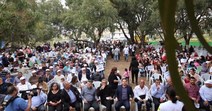
Hundreds of Palestinians rallied in the 1948 occupied lands on Saturday to commemorate the 40th anniversary of Palestine's Land Day and to express their rejection of an Israeli plan to build a city for Arabs in Jadeidi-Makr town in the Galilee.
Addressing the participants in the rally, head of the follow-up committee for Arab citizens Mohamed Barakeh condemned Israeli plans aimed at tightening the noose around the Palestinians in the 1948 occupied lands and called for standing united against all conspiracies.
For his part, Arab Knesset member Ayman Odeh criticized, in his speech, Israel's intention to build a city on lands belonging to Palestinians from Jadeidi-Makr town "We need such city, but the establishment of a city requires partnership and vast lands, and not establishing a misshapen one at the expense of people's lands," Odeh stated, warning that such Israeli plan would prevent the development of Jadeidi-Makr."
The Israeli government has recently approved a plan to build a city for Arabs, for the first time since 1948, on lands belonging to Palestinian citizens from Jadeidi-Makr town.
Addressing the participants in the rally, head of the follow-up committee for Arab citizens Mohamed Barakeh condemned Israeli plans aimed at tightening the noose around the Palestinians in the 1948 occupied lands and called for standing united against all conspiracies.
For his part, Arab Knesset member Ayman Odeh criticized, in his speech, Israel's intention to build a city on lands belonging to Palestinians from Jadeidi-Makr town "We need such city, but the establishment of a city requires partnership and vast lands, and not establishing a misshapen one at the expense of people's lands," Odeh stated, warning that such Israeli plan would prevent the development of Jadeidi-Makr."
The Israeli government has recently approved a plan to build a city for Arabs, for the first time since 1948, on lands belonging to Palestinian citizens from Jadeidi-Makr town.
22 mar 2016
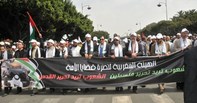
The Moroccan association for the support of the nation’s issues called on the Moroccan people to widely participate in the events marking the Palestinian Land Day on March 30.
The association declared its intention to organize the Jerusalem third forum on March 25 and 26 under the slogan “al-Magharibeh Quarter ...The forgotten right” in commemoration of the Palestinian Land Day.
The association’s central council held last week a meeting discussing a number of local and international issues. The participants started their discussion with Palestinian developments and Israeli unlawful killing of Palestinian youths especially in occupied Jerusalem.
The Palestinian prisoners’ issue and Gaza siege were also discussed during the meeting. The association expressed its total rejection of the Moroccan authorities’ normalization with the "Israeli entity", slamming the Israeli crimes against Palestinians in the West Bank and Gaza Strip.
The association also hailed Mohamed al-Qeiq’s victory, who went on hunger strike for more than three months in Israeli jails demanding his freedom from administrative detention, expressing its total support for Palestinian prisoners held in Israeli jails.
The association declared its intention to organize the Jerusalem third forum on March 25 and 26 under the slogan “al-Magharibeh Quarter ...The forgotten right” in commemoration of the Palestinian Land Day.
The association’s central council held last week a meeting discussing a number of local and international issues. The participants started their discussion with Palestinian developments and Israeli unlawful killing of Palestinian youths especially in occupied Jerusalem.
The Palestinian prisoners’ issue and Gaza siege were also discussed during the meeting. The association expressed its total rejection of the Moroccan authorities’ normalization with the "Israeli entity", slamming the Israeli crimes against Palestinians in the West Bank and Gaza Strip.
The association also hailed Mohamed al-Qeiq’s victory, who went on hunger strike for more than three months in Israeli jails demanding his freedom from administrative detention, expressing its total support for Palestinian prisoners held in Israeli jails.
13 mar 2016

The follow-up committee for Arab citizens has decided to stage a general strike in different towns and villages in the 1948 occupied territories on March 30, which marks the 40th anniversary of the Land Day.
"The Land Day anniversary is coming as the racist aggression led by [Israeli premier] Benjamin Netanyahu has escalated against our Arab masses," the committee stated in a press release on Saturday.
The committee highlighted several racist and repressive measures that had been taken by the Israeli government against the Palestinians in the 1948 occupied lands.
Head of the committee Mohamed Baraka said that the Israeli government continues to demolish Palestinian homes in the 1948 occupied territories and has a plan to demolish 50,000 others at the pretext of unlicensed construction.
He also pointed out to the Israeli ban imposed on the Islamic Movement and its relief and charitable institutions and the attempts to enact legislation allowing the Knesset to axe its Arab members.
For his part, head of the Islamic Movement Sheikh Ra'ed Salah has called for active participation in the activities and marches that would be organized to mark the Land Day in Umm Hiran village in the Negev and Arrabat al-Battuf town, north of Occupied Palestine.
March 30, is an annual day for the Palestinians to commemorate the events of that date in 1976 when the Israeli government decided to expropriate thousands of dunums of land for security and settlement purposes. A general strike and marches are organized in Arab towns and villages from the Galilee to the Negev during the occasion.
"The Land Day anniversary is coming as the racist aggression led by [Israeli premier] Benjamin Netanyahu has escalated against our Arab masses," the committee stated in a press release on Saturday.
The committee highlighted several racist and repressive measures that had been taken by the Israeli government against the Palestinians in the 1948 occupied lands.
Head of the committee Mohamed Baraka said that the Israeli government continues to demolish Palestinian homes in the 1948 occupied territories and has a plan to demolish 50,000 others at the pretext of unlicensed construction.
He also pointed out to the Israeli ban imposed on the Islamic Movement and its relief and charitable institutions and the attempts to enact legislation allowing the Knesset to axe its Arab members.
For his part, head of the Islamic Movement Sheikh Ra'ed Salah has called for active participation in the activities and marches that would be organized to mark the Land Day in Umm Hiran village in the Negev and Arrabat al-Battuf town, north of Occupied Palestine.
March 30, is an annual day for the Palestinians to commemorate the events of that date in 1976 when the Israeli government decided to expropriate thousands of dunums of land for security and settlement purposes. A general strike and marches are organized in Arab towns and villages from the Galilee to the Negev during the occasion.
Page: 2 - 1
